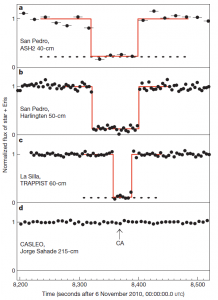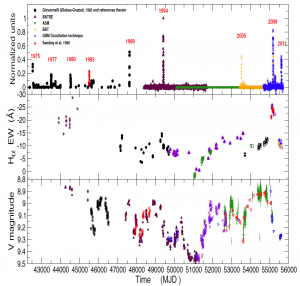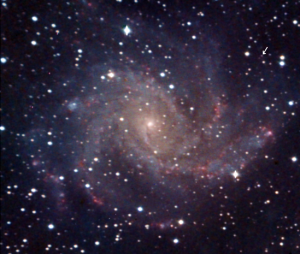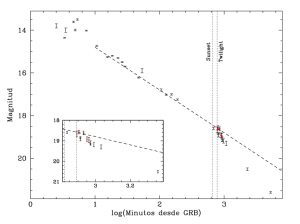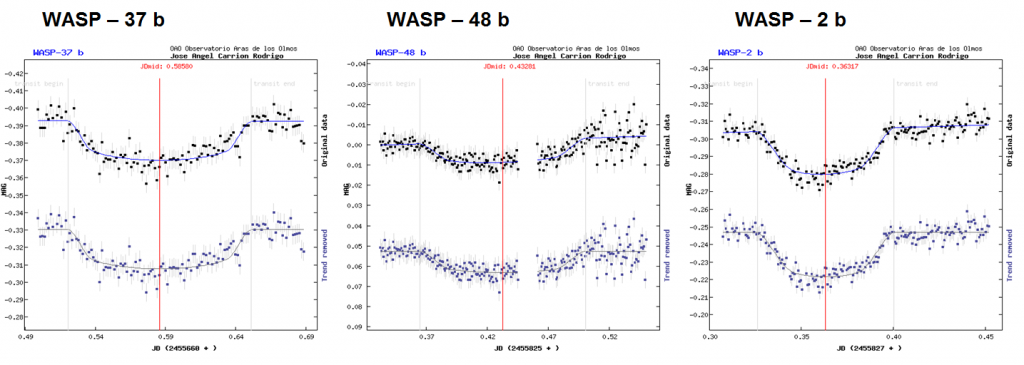Because the OAO is a general-purpose observatory with large instruments, the Aras de los Olmos Observatory offers great flexibility in the observations it organizes. For example, it carries out observations over long periods, as well as observations that require a fast response time or temporal precision, such as GRB alerts or transneptunian transits.
As a university observatory, it also hosts internships for Astronomy students not only from the Universitat de València but also from other universities. It is no wonder why its observing lines include (but are not limited to) the following areas:
- High-resolution spectroscopic follow-up (2400 l/mm grid) of Be stars, in the H-alpha region, throughout the year. The most interesting feature of these B-type stars is that they show hydrogen emission lines due to their circumstellar disks. Spectroscopic follow-up allows us to study the evolution and dynamics of the circumstellar disk surrounding these stars.
- Rotation of pre-main sequence stars. Mobile groups are of particular interest for stellar studies because their members are of the same age. The study focuses on the characterization of pre-main sequence stars belonging to the ABDoradus mobile group. Radio observations of this group confirm a correlation between stellar rotation and radio emission. Moreover, this emission seems to be more intense in the case of binaries (not necessarily close), which suggests a possible relationship between binarity and radio emission. These observations will be used to make a systematic study of the rotational velocity of these stars, which, in combination with radio observations, may contribute to a better understanding of their nature.
- Asteroseismology in BeX stars. In this project, we search for pulsation periods in BeX binary stars, with the aim of finding a relationship between the observed pulsation modes, the ejection of Be star matter, and the X-ray emission. BeX stars are binary stars formed by a massive Be star and a neutron star, which accretes matter and emits X-rays as it passes through the star’s periastron.
- Study of the variability of M stars in the Pleiades. M stars show variability on many scales, from hours to months, depending on their spectral type. Until now, this variability has always been attributed to spots and thus to the rotation period. Recent pulsation models, however, predict periods of hours that have not yet been detected. In this project, the main research focus delves into such periods.
- Tracking supernovae and optical counterparts of gamma-ray bursts (GRBs). Cosmic bursts known as GRBs (gamma-ray bursts) are routinely detected by space satellites, about a hundred a year. Their brightness is extremely intense for a very short time (a few hours), and sometimes they can be detected with very large telescopes. Taking advantage of the automatic and instantaneous data distribution network (GCN), and in case the event is visible from Aras and bright enough, we use our telescopes to follow some of these events from the OAO. Other transient phenomena, such as supernovae, have a similar follow-up.
- Tracking of asteroids, NEOs, and the critical lists. These are objects with magnitudes around 20. The data, once reduced, are sent to the Minor Planet Centre and, in the case of critical objects, to ESA-SSA.
- Observation of the optical counterparts of X-ray binaries in the course of the project “X-ray binaries”: The Optical, IR and X-Ray Connection”, of which the OAO has already performed several campaigns.
- Follow-up of trans-Neptunian occultations, in coordination with other observatories around the world. The size of these objects is determined by the “shadow” they cast on the Earth’s surface.
- Following starbursts with wide-field cameras and integrating these observations into the Spanish Meteor Network.
Some Research Proposals
- Transneptunians: “A Pluto-like radius and a high albedo for the dwarf planet Eris from an occultation”, Nature (27/10/2011). Determining the size of transneptunian Eris by occulting a star observed from various observatories around the world.
- BeX stars: “X-ray and optical observations of A 0535+26”, The Astrophysical Journal, 754:20 (16pp), 2012 July 20. Observations of the BeX type star, A 0535+26, over several years.
- Supernovae: “8.4 GHz VLBI observations of SN 2004et in NGC 6946”, Astronomy & Astrophysics 470, 1071-1077 (2007). Observation of the supernova 2004et in the galaxy NGC 6946.
- GRBs: “A tale of two GRB-SNe at a common redshift of z=0.54”, Monthly Notices of the Royal Astronomical Society, Volume 413, Issue 1 p. 669-685. Observations of two gamma-ray bursts (GRBs), GRB060729 and GRB090618, both at redshift z= 0.54.
- Exoplanets: Detections of extrasolar planets by the transit method from the TRESCA project, made by students.

